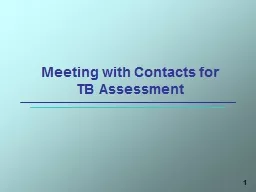

Meeting with Contacts for TB Assessment Learning Objectives After this session participants will be able to Explain why contact assessments are conducted Explain how contacts are referred for assessment ID: 247515
Download Presentation The PPT/PDF document "1" is the property of its rightful owner. Permission is granted to download and print the materials on this web site for personal, non-commercial use only, and to display it on your personal computer provided you do not modify the materials and that you retain all copyright notices contained in the materials. By downloading content from our website, you accept the terms of this agreement.
Slide1
1
Meeting with Contacts for
TB AssessmentSlide2Learning Objectives
After this session, participants will be able to: Explain why contact assessments are
conducted
Explain
how contacts are referred for assessmentExplain what information needs to be obtained from a TB contactDescribe how to maintain confidentiality when meeting with contacts
2Slide3
Determination of contacts’ TB symptoms
Gathering of social and medical information
Referral or in-person testing for TB infection with a TST or IGRA
Provision of treatment as
indicated
Why Conduct
a Contact Assessment?
3Slide4
Health department referralHealth care worker informs the contact about exposure and the need for a medical evaluation
Case referral
Case agrees to inform the contact about exposure and the need for a medical evaluation
4How Are Contacts Referred for an Assessment?(1)Slide5
The case should be given a choice of whether to inform contacts about their exposure to TB prior to health department referral process Discuss referral options with case5
How Are Contacts
Referred for an Assessment? (2)Slide6
When and How Should a Contact Assessment be Conducted?The i
nitial
c
ontact assessment should be within 3 working days of the contact having been identifiedShould be conducted in-personThe investigator should use effective communication skills
6Slide7
How Do You Conduct the Contact Visit? (1)Introduce yourself and explain purpose of visit
Ask to speak to the contact
Verify the contact’s identity
Ask to speak in privacy Inform the contact that the purpose of the visit is to discuss a health matter
Discuss
the contact’s potential exposure to
TB, but maintain the case’s confidentiality
7Slide8
How to Maintain the Case’s Confidentiality When Meeting with a Contact
Do not reveal the case’s name
Use gender neutral language
Do not mention the name of the case’s health care worker, place and dates of diagnosis, or hospitalizationDo not reveal specific dates or environment in which exposure occurredConfidentiality should not be violated even if the contact refuses to be evaluated
8Slide9
How to Maintain the Contact’s ConfidentialityInform the contact that medical evaluations may
be
shared with health care
workers who have a “need to know”Assure the contact that their information will not be shared with family, friends, or others without consent Stress that confidentiality is reinforced by local and state policies, statutes, and/or regulations
9Slide10
Provide education on TBDescribe TB assessment processAssess for TB symptoms
Administer
TST/ IGRA or schedule an
appointmentAsk questions to gather social and medical information to assess the contact’s TB risk and further guide CI effortsIdentify barriers to care and treatment
10
How Do You Conduct the
Contact Visit? (2)Slide11
Educating the Contact about TB ExplainThe difference between LTBI and TB disease
The progression
from
LTBI to TB diseaseTesting for TB infection Initial testPossibility for follow-up test Stress the importance of taking LTBI treatment, if needed11Slide12
Tips for Educating Contacts about TB Have culturally and language-specific education materials availableAvoid using medical terms and recognize when to refer questions to appropriate personnel
12Slide13Determination
of Contacts’ Potential TB Symptoms
During the initial assessment, all contacts with symptoms of TB disease should be medically examined immediately
13Slide14
Contacts should receive a TST or IGRA unless a previous, documented positive result exists A TST induration of 5 mm or larger is positive
A
contact with a
Positive TST or IGRA should be medically examined for TB diseaseNegative TST or IGRA should be re-tested 8 to 10 weeks after date of last exposure (window period)
14
Referral
or
In-Person Testing
for TB
Infection
with a TST or IGRA Slide15
Key information to obtain from contacts:Current TB symptoms (if any) and onset datesPrevious LTBI or TB (and related treatment)
Previous
TST or IGRA
resultsHIV statusOffer HIV testing if status unknownOther medical conditions or treatments that increase TB riskSocio-demographic factors
15
Obtaining Social and
Medical InformationSlide16
The decision to test a contact should be considered a commitment to treatContacts with a positive TST or IGRA should be offered LTBI treatmentOnce TB disease is excluded
Regardless of whether they received BCG
vaccine in the past
Unless there is a compelling reason not to treatContacts with TB disease need to be treated under DOT16
Provision
of
TreatmentSlide17
Reminder: Communication TipsTwo-way communication is essential to ensure the contact
Understands the information
Appreciates
the seriousness of the situationBe sure to Use open-ended questionsReinforce the contact’s understanding by asking him or her to explain your message
17Slide18
Meeting with a Contact: Demonstration by Facilitators
18Slide19
Meeting with a Contact ExerciseRefer to Appendix U
19Slide20
Review
Why are contact
assessments
conducted?How are contacts referred for assessment?What information needs to be obtained from a TB contact?How can confidentiality be maintained when
meeting with contacts?
20